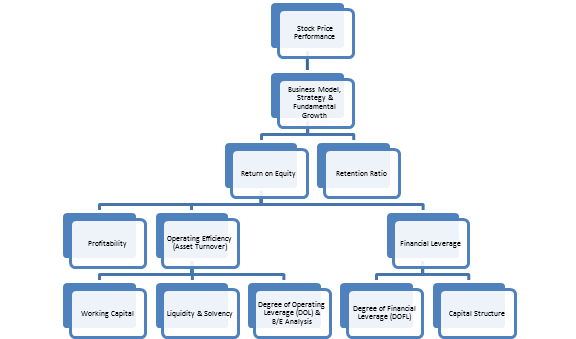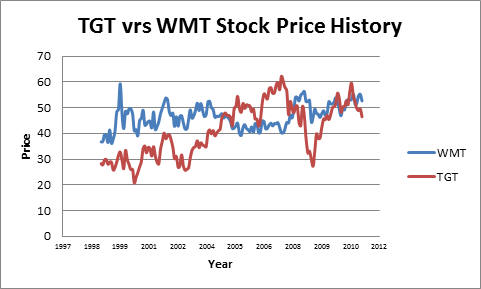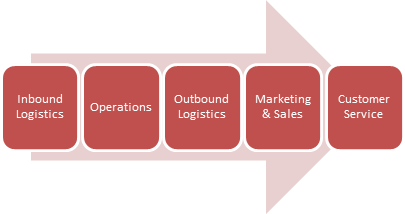4.8
Wal-Mart and Target: Strategic Differences
In the case of Amazon, we saw how getting strategy into balance
had a major impact upon stock price performance.
We now examine the impact of different strategies on
ratios and stock prices by comparing Wal-Mart and Target.
Our objective is to apply Financial Statement Analysis to
identify the relative strengths and weaknesses of these
companies (which are immediate competitors).
The tools
we will use in this case study were introduced in Chapter 3.
An overview of how we will analyze the companies is shown
in Figure 1:

Figure 1: Summary of
Business Ratio Analysis
We will
start with the stock price performance of Wal-Mart and Target.
Then, we will become acquainted with the business model
and business strategy.
After that, we will compare them along three dimensions:
profitability, operating efficiency and financial leverage.
From this, we will
identify the comparative strengths and weaknesses of Target
compared to Wal-Mart.
Stock Price Performance
Consider
the recent history of stock price performance of Wal-Mart and
Target shown in Figure 2:

Figure 2: TGT and WMT Stock Price
This
reflects a relative performance that is quite different even
though the two companies are immediate competitors.
First, you can see that WMT was less volatile than TGT.
In 2001 and 2002, there was a recession, and both stock
prices fell. You can
see that TGT recovered strongly, until the deep recession of
2008, which affected TGT much more than WMT.
Again, TGT has recovered from the decline of 2008.
Even though WMT declined in 2008, it was a much smaller
decline than TGT.
Why is
the price behavior of these two firms so different?
To answer
this question, let us first become acquainted with their
respective business models and strategies.
Business Model and Strategy
We start
with Item 1 from Target’s and Wal-Mart’s 2010 10-K.
You have already seen that this section of the 10-K
contains a lot of useful information about what the firms do and
how they do it. So
let’s see if their business models and strategies are different.
|
Target (TGT)
PART I
Item 1.
Business
General
Target Corporation (the Corporation or Target) was
incorporated in Minnesota in 1902. We operate as two
reportable segments: Retail and Credit Card.
Our Retail Segment includes all of our merchandising
operations, including our large-format general
merchandise and food discount stores in the United
States and our fully integrated online business. We
offer both everyday essentials and fashionable,
differentiated merchandise at discounted prices. Our
ability to deliver a shopping experience that is
preferred by our customers, referred to as "guests," is
supported by our strong supply chain and technology
infrastructure, a devotion to innovation that is
ingrained in our organization and culture, and our
disciplined approach to managing our current business
and investing in future growth. As a component of the
Retail Segment, our online business strategy is designed
to enable guests to purchase products seamlessly either
online or by locating them in one of our stores with the
aid of online research and location tools. Our online
shopping site offers similar merchandise categories to
those found in our stores, excluding food items and
household essentials. |
Wal-Mart (WMT)
PART I
ITEM 1. BUSINESS
General
Wal-Mart Stores, Inc. (“Wal-Mart,” the “company” or
“we”) operates retail stores in various formats around
the world and is committed to saving people money so
they can live better. We earn the trust of our customers
every day by providing a broad assortment of quality
merchandise and services at every day low prices
(“EDLP”) while fostering a culture that rewards and
embraces mutual respect, integrity and diversity. EDLP
is our pricing philosophy under which we price items at
a low price every day so our customers trust that our
prices will not change under frequent promotional
activity. Our fiscal year ends on January 31 for our
U.S., Canada and Puerto Rico operations. Our fiscal year
ends on December 31 for all other operations. During the
fiscal year ended January 31, 2010, we had net sales of
$405.0 billion.
Our operations comprise three business segments:
Wal-Mart U.S., International and Sam’s Club.
Our Wal-Mart U.S. segment is the largest segment of our
business, accounting for 63.8% of our fiscal 2010 net
sales and operates retail stores in different formats in
the United States, as well as Wal-Mart’s online retail
operations, Wal-Mart.com
|
These two
firms have a similar business model designed primarily around a
traditional physical value chain.

You can
see that they have chosen to
perform similar activities
(retail) in different ways.
The initial paragraphs in Item 1 of their respective
10-K’s make clear they have different business strategies with
respect to their marketing and sales activity.
Wal-Mart is committed to “saving people money” which can
only be implemented via a low price strategy for all the
merchandise in their stores.
Target on the other hand is committed to delivering a
“shopping experience that is preferred by our customers,” who
are referred to as “guests.”
Target therefore is committed to higher marketing
expenditure within their stores and a higher level of customer
service.
Target continues to add that their products are “both everyday
essentials and fashionable differentiated merchandise at
discount prices.”
Thus although low prices are important to their strategy,
they are not as important a component of their business strategy
compared to Wal-Mart.
Item 1
reveals a lot of interesting information about their business
strategies.
Financial statement analysis will reveal the extent to which the
strategies are working.
In fact, one of the objectives of financial statement
analysis is to assess how the managers of a company are
performing given the stated objectives of the corporation.
We will see below how the differences in strategy are
reflected in profitability, operating efficiency, and financial
leverage
